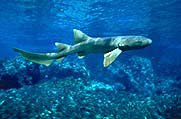
Overview
Introduction
to Sharks
Tagging and Migration
What Does Tagging Have To Do With Migration?
How Are Sharks Tagged?
Latitude and Longitude: Recording and Reporting Locations
Workbook
Activities
for Classroom
Shark Tagging Learning Activity
Nurse Sharks
 Nurse sharks are common in the tropical waters of the western Atlantic. They are
non-migratory. In fact, it seems as though they hardly move at all during the
daytime, and researchers believe that they inhabit one location for much of their
lives. They can frequently be found sitting motionless, often piled on top of
one another, while resting on the ocean floor, in caves or under coral reefs.
They are nocturnal hunters, foraging at night for bottom-dwelling marine life
such as spiny lobsters, squid, mollusks and a variety of reef dwelling animals.
Tagged individuals have been identified returning repeatedly to the same caves or
resting sites at the end of each night’s hunting. Unlike most other sharks,
the nurse shark clearly does not have to keep swimming in order to keep water
circulating over its gills. Nurse sharks are able to flutter water over their
gills while lying on the ocean floor.
Nurse sharks are common in the tropical waters of the western Atlantic. They are
non-migratory. In fact, it seems as though they hardly move at all during the
daytime, and researchers believe that they inhabit one location for much of their
lives. They can frequently be found sitting motionless, often piled on top of
one another, while resting on the ocean floor, in caves or under coral reefs.
They are nocturnal hunters, foraging at night for bottom-dwelling marine life
such as spiny lobsters, squid, mollusks and a variety of reef dwelling animals.
Tagged individuals have been identified returning repeatedly to the same caves or
resting sites at the end of each night’s hunting. Unlike most other sharks,
the nurse shark clearly does not have to keep swimming in order to keep water
circulating over its gills. Nurse sharks are able to flutter water over their
gills while lying on the ocean floor.
They are comic looking creatures with very small eyes and prominent fleshy protrusions or “nasal barbels” jutting from the base of their nose. They seem to locate their prey by touch and by smell, more than sight. Nurse sharks have strong, crushing jaws designed to feed on lobsters, crabs and shrimps as well as sea urchins and another favorite food, octopi. Because of this fishermen frequently consider them as competitors for limited shrimp and lobster catches. The nurse shark’s role in the food chain was clearly established in the Florida Keys, where they have been heavily exterminated by fishermen. Once the nurse sharks dwindled, the octopus population grew rapidly, devouring many more shrimp and lobsters than the nurse sharks consumed. Nurse sharks are also vulnerable to human impact on the environment because of their slow growth pattern of development. Nurse sharks take many years to become mature, reproductive adults. After reaching adulthood, they breed infrequently and only produce a few offspring at a time.
Nurse sharks prefer water temperatures between 20°-30°C (68-86°F). Their western Atlantic range extends from Rhode Island, in the United States, to Uruguay, including the Gulf of Mexico and the Caribbean. Since they prefer warm temperatures and feed on non-migratory animals, they remain in the same tropical locations throughout their lives. One indication of the year round residency of nurse sharks is evident in the tagging of nurse sharks off Big Pine Key in Florida. Here, scientists have recaptured nearly 30% of all the nurse sharks originally tagged. One of the mysteries of nurse shark behavior is where do the nurse sharks in the northern part of their distribution go in the winter. Nurse sharks have been caught and tagged in the summer months off of New York, but they disappear in this area in the winter months. Possibly they swim to deeper bands of warm water, but no one knows for certain their location in the cold months of the year.
Copyright © Ocean Of Know